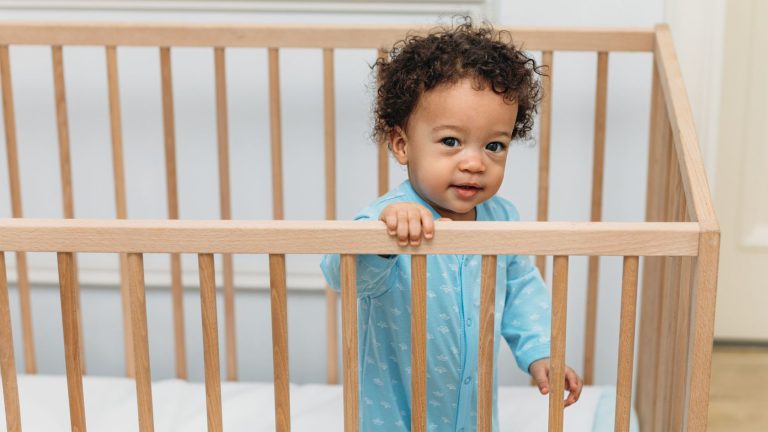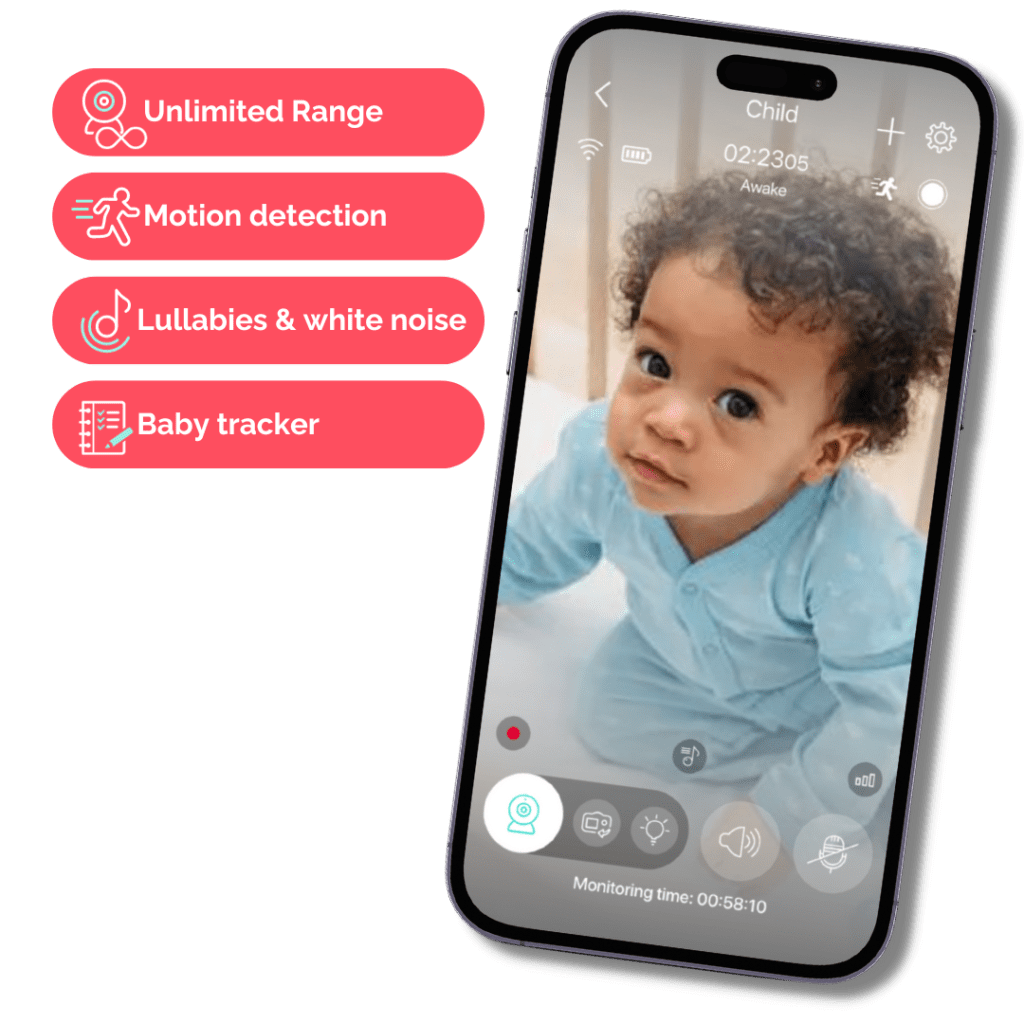
Big Step Ahead: How to Successfully Help Your Baby Make the Transition From Bassinet to Crib
- Created:
1. 9. 2023 - Updated:
10. 1. 2024
Fact:
As your baby grows and reaches certain milestones, their sleeping habits and needs evolve.
Eventually:
There comes a time when the cozy confines of their bassinet are no longer suitable for their increasing mobility. They begin to crave the space and comfort cribs provide.
Sadly:
Transitioning from bassinet to crib can be challenging since your infant must adjust to a new sleep space.
So:
In this article, we will explore essential strategies to make the switch as smooth and comfortable as possible.
Let’s get started!

When Is the Right Time to Make the Transition?
Fact is:
Transitioning from a bassinet to a crib is a significant step in a baby’s development. According to WebMD, most babies are ready to make the transition between 4 to 6 months of age.
However:
It’s essential to recognize that each baby is unique, and their readiness for this change can vary based on individual factors.
Let us take a look at some of these factors below.
1. Size and Weight
Listen:
Bassinets are designed with specific weight limits to ensure the safety and well-being of your newborn while sleeping. It indicates that it’s time to transition when your baby approaches the weight limit specified by the manufacturer.
Thus, ensure you check your baby’s weight often so you can adequately prepare for the transition.
Typically, bassinets can accommodate newborns weighing between 15 and 30 lbs. Nevertheless, it’s essential to refer to the manufacturer’s guidelines to know the exact limit for your baby’s bassinet.
2. Developmental Milestones
Now:
Another significant factor to consider is your baby’s developmental milestones. Around the age range mentioned earlier (between 4 to 6 months), many babies begin to showcase their newly found skills.
These milestones include major physical achievements, such as rolling over, pushing up on their hands and knees, or even attempting to crawl.
While these developmental milestones are exciting and indicative of your baby’s progress, they can also impact their safety in a bassinet.
In that case:
You must transition from bassinet to crib to ensure your baby’s safety and well-being.
3. Individual Readiness
When transitioning from a bassinet to a crib, every baby is unique, and there is no one-size-fits-all timeline for this change.
Some babies start showing signs of readiness earlier than the average age range. However, others might be more comfortable staying in the bassinet for longer.
What matters is that parents pay attention to their baby’s cues so they can determine the right time for this transition.
So:
Some cues you should look out for include restlessness or discomfort when placed in the bassinet.
Additionally:
If your baby is attempting to roll to their side or move around more frequently, the bassinet’s limited space is no longer sufficient for their developing skills. It’s a sign that you should make the switch.
Benefits of Transitioning to a Crib
Transitioning from a bassinet to a crib offers numerous advantages for a baby’s growth and cognitive development.
Also:
The increased space and freedom of movement in cribs aid in developing gross motor skills. This transition fosters independent sleep habits, ensuring the baby’s and parents’ rest.
The best part:
We will be exploring the insightful benefits of this important switch in detail. Let’s get to it!
| Features | Bassinet | Crib |
|---|---|---|
| Space | Bassinets are compact and cozy, suitable for newborns. However, they have limited space for movement, which can be restrictive as the baby grows. | Cribs are larger and provide ample space for a growing baby to move freely. They allow for stretching, rolling, and standing, contributing to physical development. |
| Safety | Bassinets usually have lower sides and are closer to the ground, making it easier for parents to reach out to their babies. As the baby becomes more active, they will likely try to climb out. | Cribs have higher sides, providing a secure and enclosed sleeping environment. Many cribs also come with adjustable mattress heights. This allows parents to lower the mattress as the baby becomes more mobile, reducing the risk of climbing accidents. |
| Longevity | Bassinets are typically intended for babies until they are up to 4-6 months of age. It is also dependent on the baby’s size and weight. | Cribs are more versatile and can be used for a more extended period. They often accommodate children up to 2-3 years or beyond, depending on the crib’s size and features. This ensures a more cost-effective and longer-term investment. |
| Motor skills | Bassinets limit the baby’s movement due to their confined spaces. This can hinder a child’s development of gross motor skills, such as rolling over and crawling. | Cribs allow more room for exploration and movement, therefore, facilitating the development of gross motor skills. With additional space to move and explore, your baby is exposed to various visual stimuli and experiences. This enhances their brain development and sensory processing. |
| Soothing Routines | Bassinets often come with features like rocking or swaying to soothe the baby. These can be helpful for newborns but might create sleep associations that could be challenging to break later on. | Cribs provide a stable and consistent sleep environment, making it easier for babies to learn self-soothing techniques and develop healthy sleep associations. |
| Sleep training | Bassinets are often placed next to the parent’s bed, making it convenient for nighttime feedings and comforting. However, this proximity may make it harder for some babies to transition to sleeping independently. | Cribs are often placed in a separate nursery or room, so it encourages independent sleep habits, which could aid in future transitions. This independence carries over into other aspects of their daily life as they grow. |
| Transition to toddler bed | Bassinets cannot convert into a toddler bed. Once the baby outgrows the bassinet, you must transition to a crib separately. This restricts the usefulness of bassinets to the first few months of a baby’s life. | Many cribs are designed with conversion options. They can transform into toddler beds or even daybeds. This feature helps the child feel secure in familiar surroundings and eases the potential anxiety associated with a change in their sleep environment. This adaptability also extends the usefulness of the crib. |
What to Consider When Choosing a Crib
Let’s face it:
Your baby will be spending a considerable amount of time in the crib. In that case, choosing a safe and comfortable sleeping environment that accommodates their needs as they grow is important.
Now:
With many options available, always prioritize safety by selecting a crib that meets the safety standards and certifications.
Also:
Bassinets and cribs offer distinct advantages, each catering to the unique needs and preferences of parents and their newborns.
In this section, we will explore the essential features to look out for when choosing a crib.
Ready?
1. Safety Standards and Certifications
First off:
Your baby’s safety should be the top priority when selecting a crib.
To ensure the crib meets the highest safety standards, look for certifications from reputable organizations such as the Consumer Product Safety Commission (CPSC).
In addition:
A JPMA (Juvenile Products Manufacturers Association) certification on the crib strongly indicates its compliance with rigorous safety tests.
These certifications guarantee that the crib has undergone extensive testing to ensure and meet all the necessary safety requirements.
Choosing a crib with proper safety certifications significantly reduces your baby’s risk of accidents, injuries, or health hazards.
2. Crib Quality and Fit
First:
Consider the dimensions of the crib to ensure it fits comfortably in the designated nursery space. According to the eCFR, a standard-sized crib usually measures about 52 inches in length and 28 inches in width.
However:
Before purchasing a crib, accurately measure the available area in your room or proposed nursery to avoid any fitting issues.
A well-fitted crib ensures your baby has enough space to move comfortably. It also prevents gaps between the crib and the mattress, thus reducing the risk of entrapment.
Note:
The crib mattress is equally important as the crib itself for providing a safe and comfortable sleeping environment for your baby.
Choose a firm and supportive mattress that fits snugly into the crib, leaving no gaps around the edges.
A properly fitting mattress prevents the risk of suffocation and ensures that your baby’s head won’t get stuck between the bed and the crib’s frame.
3. Adjustability and Convertibility
It’s no news:
Babies grow rapidly, and their needs change accordingly.
Therefore:
Look for cribs that offer adjustable mattress heights, allowing you to lower the mattress as your baby becomes more mobile and active.
What makes this important?
This feature ensures that the crib remains safe and prevents climbing-related accidents.
Additionally, convertible cribs are an excellent investment as they can transform into toddler beds, daybeds, or even full-sized beds. This provides value and longevity as your child grows.
4. Slats and Spacing
Fact:
The spacing between the crib slats is a crucial safety consideration.
The CPSC recommends that the space between slats should not exceed 2⅜ inches (about the width of a soda can).
This spacing prevents your baby’s head from getting stuck while allowing sufficient air circulation within the crib. Avoid cribs with wide gaps between slats, which can pose entrapment hazards.
Additionally:
The corner post of the crib should not exceed 1/16 inch. This prevents clothing or fabric from getting caught and reduces the risk of strangulation.
5. User-Friendly Instructions
Look for cribs that come with clear and comprehensive assembly instructions. The instructions should be easy to follow, even for individuals who may not have experience assembling furniture.
This helps make the setup process straightforward and minimizes the chances of errors during assembly.
Pro Tip:
Some manufacturers offer online resources, such as video tutorials or virtual assembly guides, to supplement the printed instructions.
6. Teething Rail
As your baby begins teething, it may chew on the crib’s top rail, leading to wear and tear over time.
Some cribs come with a teething rail, a protective covering shielding the crib’s top rail from damage.
Fortunately:
This feature extends the crib’s life and ensures your baby is safe from ingesting harmful materials.
7. Price and Budget
While safety and quality are paramount, finding cribs that fit your budget is also important.
Now:
It can be tempting to opt for a budget-friendly crib. However, it’s important to view the purchase as a long-term investment.
A safe, high-quality crib can be used for several years and offers more value than a lower-quality option that may need replacement sooner.
So:
Set a reasonable budget and prioritize safety and functionality over aesthetics or additional features.
8. Customer Reviews
Listen:
Before finalizing your purchase, read customer reviews and feedback on the crib you are considering.
Real-life experiences from other parents can provide valuable insights into the crib’s performance, safety, and durability.
Preparing for the Transition
Admittedly:
Transitioning a baby from a bassinet to sleeping in a crib can be a significant milestone for both the baby and the parents.
It requires patience, consistency, and understanding to make the process smooth.
Here’s a transition timeline with tips and recommendations to help you through the process:
| Phase | Timeline | Tips and Recommendations |
|---|---|---|
| Phase 1: Preparing the Sleeping Environment | 1-2 weeks before transitioning | Familiarize your baby with the crib by making them play and interact with it during the daytime. Place familiar items like a favorite stuffed animal or a piece of clothing with your scent in the crib. This can provide a sense of security for the baby. |
| Phase 2: Establishing a Sleep Routine | 1-2 weeks | Establish a consistent and calming bedtime routine that signals sleep time. This could include a warm bath, bedtime stories, singing a lullaby, or gentle rocking. Consistency helps to regulate their internal clock and promote better sleep. Also, consider using a white noise machine if the baby is accustomed to background noise. |
| Phase 3: Transitioning to the Crib | 1-2 weeks | Begin by having the baby take naps in the crib. This allows them to become familiar with the crib. Position the crib near your bed so the baby can still see and hear you. Being close provides comfort during the transition. |
| Phase 4: Nighttime Sleep in the Crib | 2-4 weeks | You should remain patient and responsive as there might be some initial resistance during this phase. Comfort and soothe the baby when they wake up at night, assuring them that you are there for them. While bringing them into your bed during difficult nights might be tempting, stay committed to having the baby sleep in the crib. Also, celebrate your baby’s milestones, no matter how small. Positive reinforcement can encourage them to adapt to the new sleeping arrangement. |
Final Tip: Annie Baby Monitor – Your Watchful Companion in the Nursery
Watching over your little one when they start sleeping on their own is important.
You can easily do that by placing a monitor in their nursery. With Annie’s real-time video and audio monitoring, as well as cry and motion detection, you can always stay connected with your child, which will give you peace of mind and give you peace of mind.

Looking for a top-notch baby monitor? Look no further than Annie Baby Monitor. It’s the perfect solution for keeping tabs on your little one. Check it out now.
Conclusion
All in all:
Transitioning a baby from a bassinet to a crib is a significant milestone in their physical and cognitive development.
Now:
The right time for this transition varies for each baby and depends on size, baby cues, and developmental milestones.
Bassinets are safe for newborns and provide a cozy space for the initial months. However, cribs offer a wider range of benefits, including:
- Ample spacing for babies to move around and explore.
- Stable and secure sleep environment.
- Safety for older toddlers and infants.
When choosing a crib, prioritize safety, crib quality, and adjustability. To make the transition smoother, introduce the crib gradually and create a familiar and comfortable sleeping environment.
Lastly:
I’m confident this post has provided practical information regarding the transition from bassinets to cribs. If you have any further questions or experiences to share, I’d love to hear them in the comment section!
FAQ: Transition From Bassinet to Crib
Consider transitioning your baby from a bassinet to a crib when they outgrow the bassinet’s weight or size limit. This is usually around 4 to 6 months old. If your baby starts showing signs of mobility, it’s a good indication that they are ready to transition to a crib. However, each baby’s development is unique. So it’s essential to monitor their progress and consult with your pediatrician if you have any concerns.
Consider introducing your baby to the crib gradually to make the transition from a bassinet to a crib easier. Create a sense of familiarity by using familiar bedding or a swaddle to provide comfort and maintain a consistent bedtime routine. Staying responsive to your baby’s needs helps provide the comfort and attention required to transition smoothly.
To ensure your baby feels comfortable in their new crib, use familiar items, such as their favorite blanket or stuffed toy. Gradually introduce the crib during supervised playtime and short naps to help them become accustomed to the new sleep space. Maintaining a consistent bedtime routine will also provide a sense of predictability, making the transition smoother for your baby.






